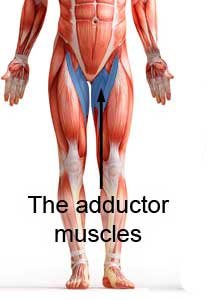 Adductor muscle injury (groin strain) is a common injury due to tearing of the adductor muscle group (groin muscles) found in the inner aspect of the thigh. These muscles arise from the pelvis and attach into the inner aspect of the thigh bone (femur) and chin bone (tibia).
Adductor muscle injury (groin strain) is a common injury due to tearing of the adductor muscle group (groin muscles) found in the inner aspect of the thigh. These muscles arise from the pelvis and attach into the inner aspect of the thigh bone (femur) and chin bone (tibia).
The function of these muscles is to move the leg towards the opposite leg (adduction). They are mainly active during running especially when changing direction and during kicking. When these muscles contract strongly, especially when they are in a position of stretch, tension is placed through the groin. If tension is excessive, some of the groin muscles can tear (groin strain).
According to its severity, groin strains are classified into:
- Grade 1: a small number of muscle fibers are torn resulting in some pain but allowing full function.
- Grade 2: a substantial muscle fibers are torn with moderate pain.
- Grade 3: all fibers are torn resulting in major loss of function.
Groin strains tend to occur more commonly in the older athlete and particularly following an inadequate warm-up.
Diagnosis:
The patients usually feels a sudden sharp pain in the inner thigh or groin during the sudden activity. If the pain is on the back of the thigh it is probably due to a hamstring injury. If the injury is mild (grade 1) the patient may be able to continue his activity. In severe cases, the patient may be unable to continue his activity and will limp or be unable to walk.
Patients with a groin strain usually experience an increase in pain during activities which place load on the groin muscles e.g. walking, running (especially while changing directions), jumping and kicking.
Squeezing the legs together and performing a groin stretch may also cause pain in patients with a groin strain.
In rare cases, MRI scan and ultrasound may be required, to confirm diagnosis and assess the severity of injury.
Treatment:
First aid:
- Apply I.C.E.(Rest, Ice, Compression, and Elevation) immediately. This helps limit the amount of internal bleeding and swelling that usually occur with this injury
- Rest and use crutches if the injury is severe.
Later:
After the initial acute stage a gradual rehabilitation program is started. This program includes gradual stretching and strengthening exercises. Stretching should be pain free starting with gentle static stretches and progress through to more sports specific stretches performed dynamically.
Early return to sports before complete healing and rehabilitation may cause recurrence of the injury leading to a chronic injury.

